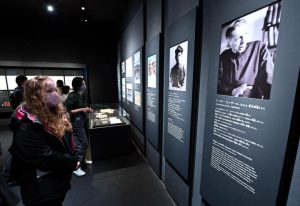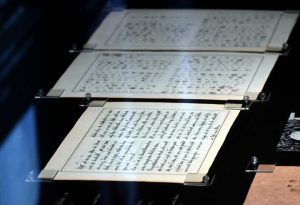Hiroshima Summit—Starting point for abolition of nuclear weapons, Part 7: A-bomb survivors from overseas
Feb. 17, 2023
Entire picture remains unclear, but efforts were made to save lives after bombing
by Miho Kuwajima, Staff Writer
“From a distance, I could hear someone’s voice crying out, ‘Help, help.’ But I didn’t know from where the voice originated. Listening carefully, I finally made out that the voices were of a mother and her two daughters trapped under their two-story home. We dug out two of them on the spot, and the other’s rescue was left to a civil defense force.”
The above is an entry from a diary written 12 days after the atomic bombing by Father Klaus Luhmer, a German who died in 2011 at age of 94, about his experience of having rescued a mother and her daughters at night on August 6, 1945, after he himself experienced the atomic bombing of Hiroshima.
At the time of the bombing, Father Luhmer was in the Nagatsuka Jesuit novitiate in the area of Gion-cho (now part of Hiroshima’s Asaminami Ward), located about 4.5 kilometers from the hypocenter. He was hit by shards of glass but avoided serious injury. Under the direction of Pedro Arrupe, who died in 1991 at the age of 83, the Spanish rector of the novitiate who had a background in medicine, Mr. Luhmer and other priests and nuns worked hard to take care of the many wounded arriving there.
That night, he roused himself and headed to the Noboricho Church and the parish house located in the central area of Hiroshima (now part of the city’s Naka Ward) with a priest colleague for the purpose of finding and saving Father Hugo Lassalle, who had been seriously injured in the bombing and died in 1990 at the age of 91. When the priests passed by the area on the east side of Misasa Bridge (in present-day Naka Ward), located about 1.4 kilometers from the hypocenter, they heard the voices of the mother and daughters.
“Father Luhmer saved my life”
Father Luhmer tried to locate the source of the voices by shouting out, “Are you here; are you here?” Responding from under the collapsed home, the mother beseeched the passers-by, “My daughter is trapped. Please help.” The girl who was finally pulled out by the priest and his colleague was Michiko Osawa, 93, a resident of Hiroshima’s Nishi Ward. Ms. Osawa was 15 at the time and could not escape from under the house because she had been trapped between pillars after the bombing and was preparing to die. “Father Luhmer allowed me to live this long. I owe my life to him,” Ms. Osawa said, looking back on that time.
Nevertheless, her brother-in-law, buried alive under the home with her, died instantly. Her older pregnant sister lost her unborn child and then died herself in October later that year. Her mother was often in ill health and died in 1956. Father Luhmer wrote in his diary, “For the rest of my life, I will never forget what those three people said to me and my feelings at the time.”
The atomic bomb dropped by the U.S. military struck Hiroshima’s people in indiscriminate fashion. From before the war, the Society of Jesus had a base of operations in Hiroshima. Thirteen German priests, including Father Luhmer, are known to have experienced the atomic bombing. All survived and engaged in rescue operations without rest or sleep. The priests feared for their physical safety because they were sometimes mistaken for U.S. soldiers.
Meanwhile, also experiencing and dying in the atomic bombing were U.S. soldiers captured as prisoners of war, as well as such residents of Hiroshima as White Russians, Koreans, and international students from China and Southeast Asia. Since that time, 78 years have passed, but the entire picture is still unclear even now about the nationalities and populations of people from overseas who experienced the atomic bombing.
Worldwide issue
To demonstrate the suffering of such individuals, the Hiroshima Peace Memorial Museum, located in the city’s Naka Ward, established a new exhibit area depicting overseas A-bomb victims in 2019. The area displays a copy of Father Luhmer’s diary and A-bomb drawings showing how he had transported the wounded. Yumi Abe, 68, Ms. Osawa’s daughter who lives in Hiroshima’s Nishi Ward, has introduced visitors from around the world to that section of the museum as an English guide. “I desperately hope the participants of the G7 summit meeting see this section. They should come to the awareness that this is a global issue independent of nationality.”
Father Lassalle, the priest Father Luhmer had gone to rescue on the day of the bombing, dedicated himself to establishing the Memorial Cathedral for World Peace, in Hiroshima’s Naka Ward, following the end of the war. His words are recorded in a testimonial video produced in 1983. “Humans must take a step forward. War cannot be allowed.”
(Originally published on February 17, 2023)









